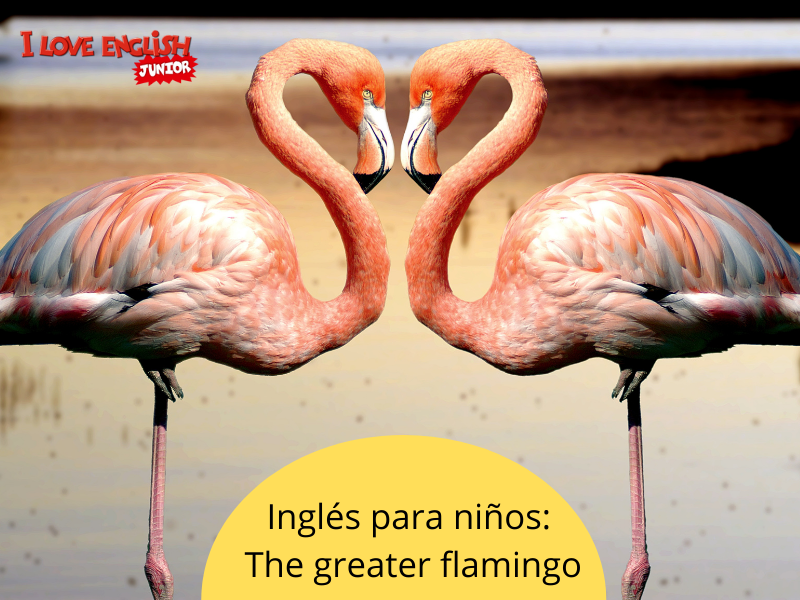Lectura en inglés para niños: the greater flamingo
10 datos sorprendentes sobre los flamencos para que los niños aprendan inglés de forma divertida
Publicado por Alba Caraballo, editora de Conmishijos.com
Creado: 1 de junio de 2023 16:06 | Modificado: 9 de abril de 2025 08:22
Te invitamos a leer 10 datos asombrosos sobre los flamencos: The greater flamingo. Una lectura muy divertida e interesante para niños de Primaria, de la mano de la revista para aprender inglés I Love English Junior (marzo - abril 2022, número 122).
Los niños conocerán datos sorprendentes sobre estas aves de presa. Además, aprenderán nuevo vocabulario y practicarán la lectura en inglés.
Ver +: Lecturas para niños en inglés
The grater flamingo (El gran flamenco), lectura en inglés para niños

1. There are six flamingo species: the greater flamingo, the lesser flamingo (in Africa and India), the Chilean flamingo (South America), the James?s flamingo and the Andean flamingo (Peru, Chile, Bolivia and Argentina), and the American flamingo (Caribbean islands). So they can be found on every continent except for Australia and Antarctica!
2. The greater flamingo lives in the wetlands of southern Europe, Africa, India and the Middle East. They particularly like estuaries and saline or alkaline lakes. It is the largest species of the flamingo family and is about 110-150 cm tall.
3. Flamingos are omnivores. They eat algae, plankton, molluscs, seeds and small crustaceans. They sometimes even eat crabs and small fish. To eat, first they use their legs and feet to stir up the bottom of the lake. Then, they bury their beaks or even their heads in the water. Finally, they scoop up algae and crustaceans in their beaks.
4. Flamingos mostly drink salt water ? without the salt! They have tiny organs on their heads which they use to filter out the salt from the water. After sipping the water, the salt discharges through their nostrils. By the way, did you know that flamingos can safely drink water as hot as 60°C? An extra-tough coating inside their throat and mouth allows them to do this.
5. When they migrate, they can travel approximately 600 km in one night, at speeds of up to 60 km per hour. They are good fliers, but they have to run and flap their wings to take off! They can fly for hundreds of kilometres a day to find food. They can swim well too!
6. When they rest, they stand on one leg. Flamingos are able to balance on one leg and, comfortably, save energy. This is because this position is more energy-efficient and safer than standing on two legs. If a predator approaches, the flamingo can get away quickly.
7. Most of the watery habitats that flamingos live in are very toxic. These waterways contain corrosive chemicals that would burn off human skin! But the hard scales located on flamingos? legs protect them from predators.
8. Flamingos live in large groups called colonies. These colonies give protection against predators too, especially when a bird has its head in the mud! Flamingos even breed in their colonies. The largest colony of flamingos is in East Africa ? there are one million birds in a colony!
9. Flamingos make nests from mud. A female usually lays one egg. Male and female flamingos sit on the egg, which hatches after between 27-31 days. Chicks are born with grey or white feathers, which turn pink at about the age of two because of the algae and shrimp they eat.
10. Do you know what a group of flamingos is called? The noun to describe a group of flamingos is "flamboyance". "Flamboyance" is an appropriate term for these birds, as they are resplendent or flamboyant! Thousands of them can flock together on salt flats, lagoons, lakes and swamps.
Artículos relacionados
Lectura en inglés para niños: 10 amazing facts about platypuses
Te invitamos a leer 10 datos asombrosos sobre los ornitorrincos: 10 amazing facts about platypuses. Una lectura muy divertida e interesante para niños de...
Ejercicios en inglés para niños: divertidas fichas para imprimir
Ejercicios en inglés para niños que puedes imprimir para que el niño realice en su tiempo libre. Son divertidos y amenos, por lo que será divertido repasar y...
34 trabalenguas en inglés para niños
Hemos reunido 34 trabalenguas en inglés para niños, incluida la traducción al español, con la que pueden practicar y mejorar su pronunciación en inglés.
Inglés para niños: 10 amazing facts about eagles
Te invitamos a leer 10 datos asombrosos sobre las águilas: 10 amazing facts about eagles. Una lectura muy divertida e interesante para niños de Primaria, de la...
Días de la semana en inglés. Ejercicio de inglés para niños
Los días de la semana (days of the week) es uno de los primeros aprendizajes que se realiza, por lo tanto, será perfecto poder repasarlos y practicarlos con este...
Estaciones del año en inglés. Ejercicio para niños (Seasons of the year)
Con este ejercicio sobre las estaciones en inglés para niños, tus hijos o tus alumnos podrán repasar lo que han aprendido en el colegio. Esta ficha de inglés:...
Comentarios
¡Sé el primero en comentar!


















